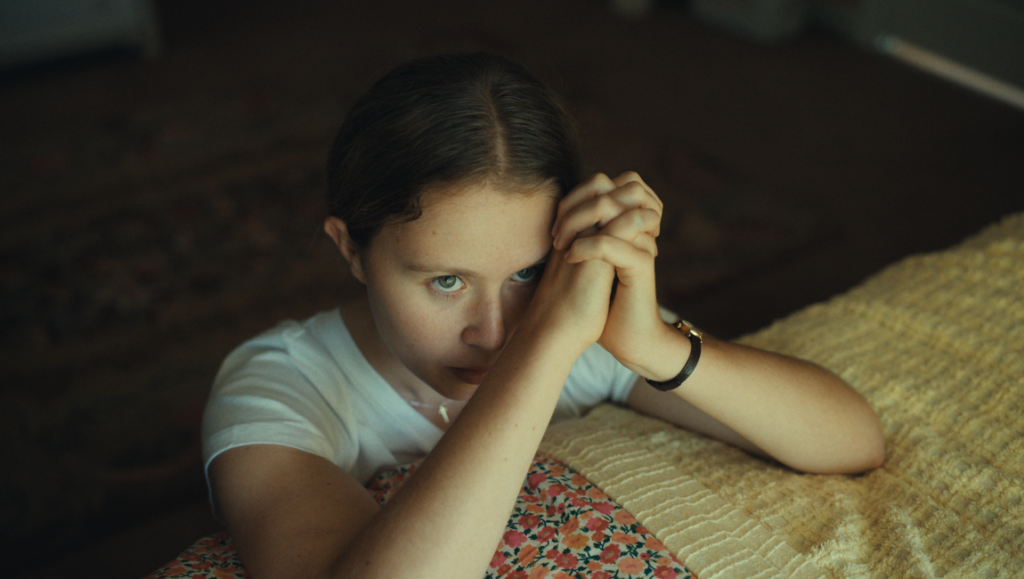Writer-director Laurel Parmet’s The Starling Girl opens with 17-year-old Jem Starling (Eliza Scanlen) dancing with her church’s worship troupe. It’s clear that dancing brings Jem happiness and a modicum of freedom amidst the surveilling eyes of churchgoers. Immediately after, she is publicly shamed by an older woman for wearing a bra that’s visible under her shirt. In tears, Jem rushes out of the church, and that’s when she meets 28-year-old Owen Taylor (Lewis Pullman), the head pastor’s eldest son, smoking a cigarette. He asks her not to tell. The warped and twisted power dynamic between Owen and Jem that follows in Parmet’s debut feature is laid bare in this opening scene — she’s not allowed to tell, and her shame must be buried beneath layers of clothes in spite of the relentless Kentucky sun. He’s laid back, smoking a cigarette in public, free from the fear of punishment. Religious hypocrisy and a teenage girl’s burgeoning sexuality do not mix well together. Owen knows this, and initiates an extramarital affair with Jem, who craves his validation for desires that she is prohibited from exploring.
At home, Jem is the eldest daughter in a large family who is constantly tasked with household chores and caretaker duties to her younger siblings. Her father, Paul (Jimmi Simpson), is an alcoholic. One time, Jem opens the wrong bedroom door and finds him wasted and half-naked. Another time, he hits her in a drunken outburst. Her mother, Heidi (Wrenn Schmidt), asks Jem not to tell, out of fear that his “Satanic” temptations would bring shame to the family. She insists that Paul is fine, and so wilfully deludes herself into believing that Jem is fine with her father’s illness too. It’s at home that Jem learns that the body and all its desires — especially her own — is a place of guilt, lust, and sin. As her sense of self is torn apart, it’s unsurprising that she sees her illicit affair with Owen as a way to rebel against her fundamentalist upbringing. After all, Owen is everything that Jem hasn’t been allowed to be: he’s traveled overseas and, more importantly, has a much more fluid relationship with God, one where biblical rules can be broken with impunity.
By carefully illuminating the fraught relationships that Jem shares with her parents and her religion, Parmet allows the audience to see why and how Owen’s treatment of Jem is predatory and manipulative — even as Jem wholeheartedly believes that she’s reclaiming her sexual agency. In The Starling Girl, the sun’s glare is always rendered excessively harsh and almost nauseating to behold; this choice imbues Owen and Jem’s encounters with a sickly discomfort that mirrors the latter’s inner turmoil and vulnerability. When they have sex for the first time, the camera focuses on Jem’s hurt and anguish, and denies the audience the gratification of witnessing Owen’s perverse pleasure. Through a consistent emphasis on Jem’s point of view — her fears, conflicted desires, and deep-rooted Christian guilt, The Starling Girl criticizes the orthodox environment that carelessly allows sexual abuse to flourish, and the evangelical community’s close-mindedness, hypocrisy, and indoctrination are subsequently placed on trial. In lesser hands, a premise involving a younger girl and a married man might have been utilized for titillating spectacle. Parmet’s film, however, is awash with empathy for teenage girls whose senses of self have been destroyed by religious puritanism.
Scanlen has received critical acclaim for playing deviously complex and rebellious women in works like Sharp Objects and Babyteeth, and her performance in The Starling Girl arrives as both nuanced and momentous. She precisely capures Jem’s naïveté and youthful innocence, but also delicately reveals how this naïveté is gradually worn down by sexual abuse and familial neglect. Alongside Scanlen is Schmidt’s towering turn as Heidi, a religiously compliant woman whose self-righteous denial about her husband’s indiscretions is only barely intact. Heidi’s own guilt over failing to be a picture-perfect wife manifests in her cruelty toward Jem, especially when she kicks Jem out after confessing to the affair. Religious trauma spans generations, and Parmet paints a deeply and justifiably pessimistic look at a cloistered and insular community that would rather girls like Jem be sent to conversion camp in order to protect the abusive men in their ranks.
While Parmet’s coming-of-age narrative is predictably structured, with the exposure of Owen and Jem’s illicit relationship perfectly timed toward the film’s end, it nonetheless boasts searing moments of tenderness that add surprising depth to a common subgenre. In particular, the loving scenes between Jem and Paul, while rare, give the audience a glimpse into a freer world where men can be true fathers to their daughters. While intoxicated, Paul tells Jem about his worldly life before devoting himself to God: he was a country singer who played in a band, and his continued love for music, an expression of unbridled individuality, resembles Jem’s love for dance. Later on, in a moment of sadness, Paul offers Jem the one thing she hasn’t received before from the adults in her life — a heartfelt apology for mistreating her. It’s here that The Starling Girl offers what religion has failed to give its tortured believers: grace.
Published as part of InRO Weekly — Volume 1, Issue 19.


Comments are closed.